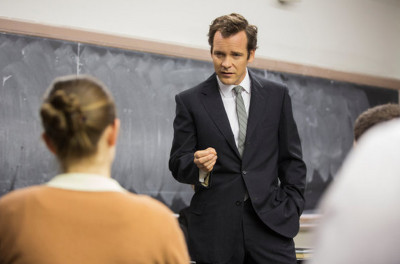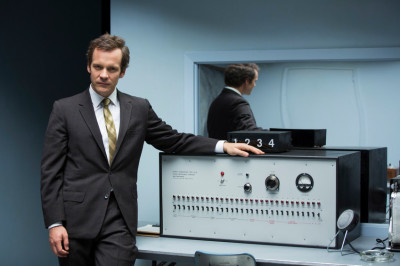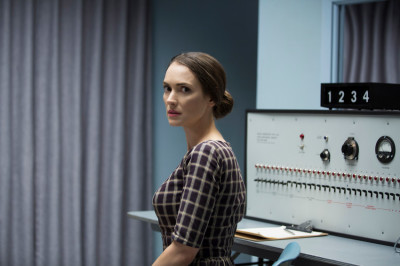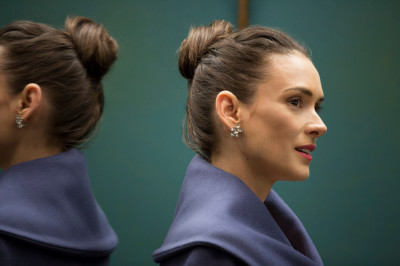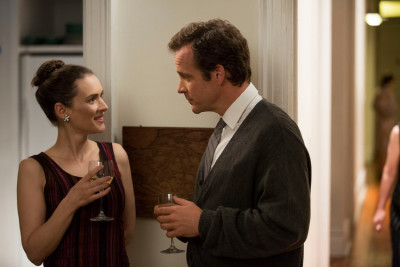You had me at Michael Almereyda. For those unfamiliar with writer/director Michael Almereyda, he is a creator who thinks outside the box. With an eclectic mix of documentaries and short films to his credit as both writer and director, as well as countless articles and criticisms for some more erudite publications, possibly his most well known works are “Hamlet” in 2000 and then last year’s stunning “Cymbeline.” Almereyda sees words and their applicability to different times, different worlds and has the ability to find topical melds that enrich, engage and entertain. He does that again with EXPERIMENTER by upping the ante and thinking outside the box, demonstrating intelligent creativity in design and storytelling and bringing a key part of societal study to life with EXPERIMENTER. A perfect blend of performance art, cinema and the science of psychology, the result is thought provoking, profound and beyond intelligently entertaining. There is a permeating playfulness that is, dare I use the word again, intelligent and refreshing. Almereyda never dumbs down the audience or dumbs down to the audience. He forces us to up our own intelligence quotient of understanding and curiosity and inquisitiveness.
Almost anyone who has taken a psychology class in college knows of Stanley Milgram, his obedience studies and his seminal book, “Obedience to Authority.” Focus group leaders, jury consultants and many other professionals still rely on Milgram’s writings and experiments for things such as jury selection, even tv and film marketing for the study of individuals reacting to and replicating response “a la sheep” and the obedience aspect of response, following jury instructions, etc. The applications of his principles are widespread even today. But let’s not overlook Milgram’s “5.5 degrees of separation” or the “lost letter experiments”. Each study and its theories are inexplicably interwoven into the tapestry of human behavior. Milgram always thought outside the box and Almereyda pays homage to that by doing the very same thing in his design of EXPERIMENTER and the megalomaniacal brilliance of Milgram. A biopic? Or an observational study of the human behavior that was Stanley Milgram?
We first meet Stanley Milgram in his laboratory at Yale. The time is 1961. Milgram is about to commence the first of his “obedience studies”. The premise is a simple one. Milgram stands behind a two-way mirror, watching willing subjects and monitoring not only their stress levels, but their obedience levels. Hidden from each other, one subject is “Teacher” and the other “Learner.” Teacher would ask a question and Learner must respond. If the student gave an incorrect answer, Teacher would administer a shock that would increase in intensity as the exam went forward. As the audience learns, but the subjects don’t know, is that Learner was, in fact, a colleague of Milgram’s and there were no shocks being administered; Learner would merely make horrific painful sounds to push Teacher’s own psychological buttons. Would Teacher adhere to the commands and demands of the experiment and continue to inflict electric shocks on Learner knowing it was causing pain? Or, would he defy authority and stop? Interestingly, the majority of the Teacher subjects would continue to administer shocks when instructed to do so by the authority figure running the experiment, something which Milgram would call “the agentic state”. (The parameters of the experiment and the “deceit” practiced by Milgram in its protocol has enticed many to call his ethics into question and remains a hot button debate topic even today.)
Moving from the lab and into the halls of academia, Milgram speaks directly to the camera (as he does often throughout EXPERIMENTER, as if the proud puppeteer or directing, staging life as a production on his own terms) explaining his thought process and the concept of his experiment, citing to then Holocaust as an example. Can everyday average people be commanded or coerced into performing the unthinkable? As Milgram walks and talks, an elephant lumbers in the hallway behind him.
We soon meet Sasha, who would eventually become Milgram’s wife. Almost as if a psychological appendage to Milgram himself, Sasha exposes a human, albeit restrained, side of Milgram. She also provides a layman’s entry into the world of social psychology as well as showing that an average everyday person, without the benefit of doctoral degrees, can understand Milgram’s philosophies.
Thanks to his own arrogance, Milgram’s work in the United States comes to a standstill and he travels oversees to steep himself in European enlightenment. Through it all, Sasha is by his side, never faltering. More experiments come and go, as do more books, articles and lectures, but the obedience experiment is the one that keeps haunting Milgram, the one that people remember, the one that Hollywood even saw fit to adapt into a 1975/76 CBS tv movie starring William Shatner and Ossie Davis (seriously).
With thoughtful recreations, performance art and rear projection imagery metaphorically unfolding to bring Milgram’s story and his world to life, we are there until the bitter end when a weak heart ended his life in 1984. But Stanley Milgram’s life and legacy is never more exquisitely depicted than in a defining coda of Alexandra “Sasha” Milgram herself participating in a modern day recreation of one of Milgram’s experiments.
Written and directed by Michael Almereyda, I am enthralled with his cinematic structure. He creates a clinical feel, and in many cases, with a theatrical stage backdrop (thanks to the rear-projection technique), incorporating the elements of performance art punctuated by narrative vignettes. Unique, textured, Almereyda goes outside the box; just like Milgram’s experiments. The appearance of an elephant is BRILLIANT as Milgram’s studies – and particularly the obedience study – was equivalent to always having “an elephant in the room”, and as briefly mentioned at the outset, still is even today in some schools of thought, due to the various ways of interpretation given his “deception” of his subjects. A stylized tonal bandwidth and the use of a predominantly clinical color palette allows one to focus on the experiments, on the subjects. And on the subject of Sasha – who while written and performed by Ryder with strong subtlety – is the backbone to Milgram.
For anyone familiar with Milgram’s book “Obedience to Authority”, you will recognize the depth of Almereyda’s research as he deftly moves EXPERIMENTER through not only the obedience studies, but connects the dots with the ethical questions and accusations raised thereafter and the ultimate unwillingness of people to admit to the truth of his findings about human nature when relieved of responsibility for their own actions. But going beyond the clinical, Almereyda humanizes a seemingly inhuman man with not only the integration of Sasha and eventually their children into Milgram’s life and the film, but Milgram’s own insecurities, foibles and routs with celebrity. The script is written with layered complexity as are the characters, distinguishing them from the simplicity of Milgram’s experiments.
Peter Sarsgaard embodies the essence of Stanley Milgram. His vocal cadence and tonal balance is befitting a man studying social psychology. There is little to no deviance of emotion when he speaks. He approaches everything with a degree of clinicism – but for wife Sasha. And then there’s Winona Ryder who has found herself again in recent years; first, in “The Iceman” and now here where, as Sasha, she is grounded strength, inquisitive, full of life and color. Ryder fascinates.
Similarly, the supporting cast is a “who’s who” of excellence – Jim Gaffigan (whose character really embraces the wit of Milgram with an “inside joke” aspect of the experiment as Milgram’s assistant), and Anthony Edwards, John Leguizamo, Tom Farrell and Anton Yelchin as superbly diverse “Learners”. But hand in hand with the supporting cast of EXPERIMENTER is the recreation of Milgram watching his original obedience experiments be adapted as the telemovie with William Shatner and Ossie Davis. Get ready to be transported through time folks as Kellan Lutz is perfection as a young William Shatner while Dennis Haysbert nails Ossie Davis.
Ryan Samul soars with his cinematography. Long a fan of Samul thanks to his work with Jim Mickle in “Cold In July”, “Stake Land” and “We Are What We Are”, plus Brian Miller’s “Officer Down”, his eclectic vision and skill set is ideal for this stylized blend of performance art and cinema. Samul brings a meld of starkness and texture, concurrently creating visually stimulating emotional response and engagement through light and lens, thanks to eclectic use of production design and color.
And then there’s Bryan Senti’s scoring that goes beyond the individual period tracks. Eclectic and unique, Senti’s work is a perfect complement to Milgram’s own legacy.
EXPERIMENTER is as thought provoking, profound and beyond intelligently entertaining as the experimenter himself, Stanley Milgram.
Written and Directed by Michael Almereyda
Cast: Peter Sarsgaard, Winona Ryder, Jim Gaffigan, Dennis Haysbert, Kellan Lutz, John Leguizamo, Anton Yelchin, Anthony Edwards

